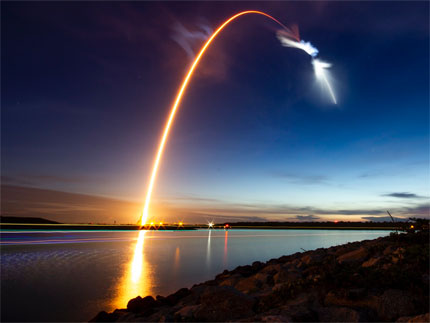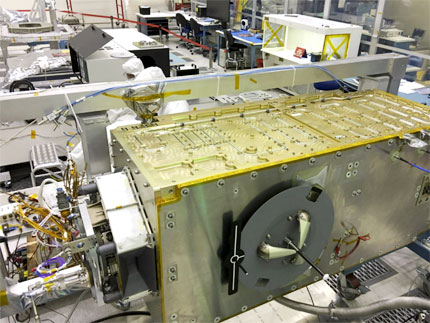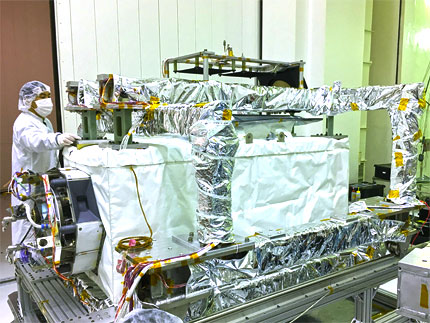Soil Science Society of America
5585 Guilford Road • Madison, WI 53711-5801 • 608-273-8080 • Fax 608-273-2021
www.soils.org
Twitter | Facebook
NEWS RELEASE
Contact: Hanna Jeske, Associate Director of Marketing and Brand Strategy, 608-268-3972, hjeske@sciencesocieties.org
Houston, we’re here to help the farmers
Farmers irrigating their crops may soon be getting some help from space. In 2018, scientists launched ECOSTRESS, a new instrument now attached to the International Space Station. Its mission: to gather data on how plants use water across the world.
The ECOsystem Spaceborne Thermal Radiometer Experiment on Space Station (ECOSTRESS) helps scientists answer three broad questions:
- How do plants respond to drought?
- What’s happening with plants’ water use over the course of a day?
- Can vulnerability to drought be reduced through more monitoring?
 “Technically, the instruments are measuring surface temperature, which reflects the heat stress of plants,” explains Joshua Fisher of NASA’s Jet Propulsion Laboratory. Fisher is the science lead on the ECOSTRESS mission. “By measuring the temperature, we are able to tell how much water plants are using. For example, if you have two plants and water one, the one that has more water will be cooler.”
“Technically, the instruments are measuring surface temperature, which reflects the heat stress of plants,” explains Joshua Fisher of NASA’s Jet Propulsion Laboratory. Fisher is the science lead on the ECOSTRESS mission. “By measuring the temperature, we are able to tell how much water plants are using. For example, if you have two plants and water one, the one that has more water will be cooler.”
The temperature measurement can be compared to holding a hand over hot sand at the beach. Even without touching the sand, a person can tell it’s hot. That’s the kind of energy ECOSTRESS picks up.
And the system is taking measurements at various times of day, thanks to the Space Station’s unique orbit. That’s important: Plants function differently throughout the day.
When plants have enough water, they open pores in their leaves (the stomata) to take up carbon dioxide for photosynthesis. When opening the stomata, the plant loses water. However, a water-stressed plant, even before a full drought, will protectively close the stomata to conserve water. While the plant retains precious water, it also cools off less.
Using the temperature data from ECOSTRESS, scientists are able to calculate evapotranspiration—the amount of water evaporating from the surface of the Earth and from plants. “And for farmers, this information is the number one requirement for irrigation. It’s useful for them to know how much to water plants. And it helps indicate future droughts and weather changes.”
 Having this kind of information can tell researchers how much water is going up into the atmosphere and also how much energy is being used to do that. It can also show which plants are being more efficient with their water and which are stressed because they don’t have enough. It can do this on a surprisingly small scale: down to 230 square feet.
Having this kind of information can tell researchers how much water is going up into the atmosphere and also how much energy is being used to do that. It can also show which plants are being more efficient with their water and which are stressed because they don’t have enough. It can do this on a surprisingly small scale: down to 230 square feet.
“We are working with water managers and agricultural specialists who want these data so they can get them to the farmers they work with,” Fisher says. “We have a whole office at NASA that connects societal users with our data so it can be used to help farmers and others make better decisions.”
 The project is an international collaboration. Astronauts performed a six-hour spacewalk to prepare for ECOSTRESS to arrive. A Canadian robotic arm took ECOSTRESS off its cargo spacecraft and passed it to the Japanese robotic arm for installation. ECOSTRESS uses the space station’s power and communications to collect data and send it down to Fisher and his team.
The project is an international collaboration. Astronauts performed a six-hour spacewalk to prepare for ECOSTRESS to arrive. A Canadian robotic arm took ECOSTRESS off its cargo spacecraft and passed it to the Japanese robotic arm for installation. ECOSTRESS uses the space station’s power and communications to collect data and send it down to Fisher and his team.
“This was the first launch I went to and it was really something special,” Fisher says. “I got interested in this work after growing up splitting time between Los Angeles and Alaska and thinking about a bigger vision of how life on Earth persists and thrives. Evapotranspiration is the number one climatic predictor of biodiversity. When you have a lot of water and energy, you have a lot of life.”
Fisher presented his research at the Soil Science Society of America's International Soils Meeting, Jan. 6-9, 2019 in San Diego.